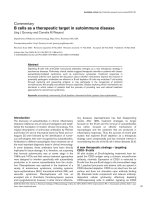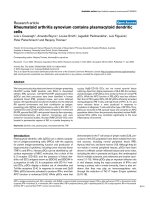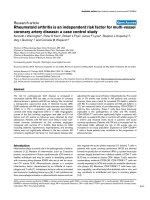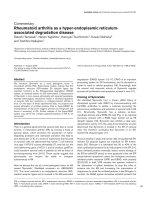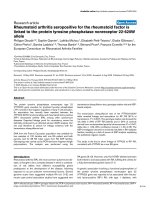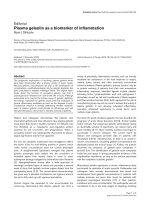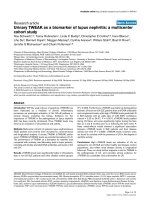Báo cáo y học: "Rheumatoid arthritis as a hyper-endoplasmic reticulumassociated degradation disease" pdf
Bạn đang xem bản rút gọn của tài liệu. Xem và tải ngay bản đầy đủ của tài liệu tại đây (316.2 KB, 6 trang )
181
CIA = collagen-induced arthritis; ER = endoplasmic reticulum; ERAD = endoplasmic reticulum-associated degradation; RA = rheumatoid arthritis;
RSC = rheumatoid synovial cells; siRNA = small interfering RNA; TNF = tumor necrosis factor; TUNEL = TdT-mediated dUTP nick end labelling;
UPR = unfolded protein response.
Available online />Abstract
We introduce Synoviolin as a novel pathogenic factor in
rheumatoid arthritis (RA). Experimental studies indicate that this
endoplasmic reticulum (ER)-resident E3 ubiquitin ligase has
important functions in the ER-associated degradation (ERAD)
system, an essential system for ER homeostasis. Overexpression
of Synoviolin in mice causes arthropathy with synovial hyperplasia,
whereas heterozygous knockdown results in increased apoptosis
of synovial cells and resistance to collagen-induced arthritis in
mice. On the basis of these experimental data, we propose that
excess elimination of unfolded proteins (that is, ‘hyper-ERAD’) by
overexpression of Synoviolin triggers synovial cell overgrowth and
hence a worsening of RA. Further analysis of the hyper-ERAD
system may permit the complex pathomechanisms of RA to be
uncovered.
Introduction
There is a general agreement that synovial cells have a crucial
function in rheumatoid arthritis (RA) by forming a mass of
synovial tissue, which promotes the production of matrix-
degrading proteases and osteoclast activation that lead to
joint destruction [1-6]. In a series of experiments that focused
on synovial cells, we determined that human T cell leukemia
virus type I (HTLV-I) causes arthropathy [7], and that tax, the
viral transforming gene of HTLV-1, and its product, pp40Tax,
could transform synovial cells of patients as well as those of
tax-overexpressing mice [8-10]. These results suggest that
synoviocytes can acquire the ability to overgrow
autonomously in RA.
Here we discuss the role of a novel pathogenic factor for RA
named ‘Synoviolin’ (GenBank accession no. AB024690)
[11]. This novel molecule is an endoplasmic reticulum (ER)-
resident ubiquitin ligase and is involved in the ER-associated
degradation (ERAD) system [12-17]. ERAD is an important
processing system for ER homeostasis, and its disruption is
known to result in cellular apoptosis [18]. Surprisingly, both
the amount and enzymatic activity of Synoviolin regulate
synovial cell proliferation and apoptosis, at least in mice [11].
Cloning of Synoviolin
We identified Synoviolin from a human cDNA library of
rheumatoid synovial cells (RSC) by immunoscreening with
anti-RSC antibodies to isolate a molecule promoting the
autonomous proliferation and activation of synovial cells in RA
[11]. Structurally, Synoviolin has a putative six-trans-
membrane domain and a RING-H2 motif (Fig. 1). As reported
previously, proteins with a RING finger domain act as E3
ubiquitin ligases [19], Synoviolin also exhibits a clear auto-
ubiquitination activity [11]. By using immunostaining, we also
determined that Synoviolin is located in the ER of synovial
cells. We therefore concluded that Synoviolin is an ER-
resident E3 ubiquitin ligase [11].
Previous studies in yeast and human cells concluded that ER-
resident E3 ubiquitin ligases are important for ER homeo-
stasis [20]. Because it is estimated that 30 to 40% of the
newly synthesized proteins fail to fold properly in the ER [21],
these unfolded proteins eventually induce severe damage of
the ER (so-called ER stress) or even apoptosis of the cell (ER
stress-induced apoptosis) unless two biological processes,
unfolded protein response (UPR) and ERAD, work properly
[20,22,23]. In brief, UPR contains two systems involved in
the attenuation of global translation to stop the influx of
proteins into the ER and increasing the transcription of
chaperones to refold the unfolded proteins in the ER again. In
contrast, the ERAD system eliminates unfolded proteins that
Commentary
Rheumatoid arthritis as a hyper-endoplasmic reticulum-
associated degradation disease
Satoshi Yamasaki
1
, Naoko Yagishita
1
, Kaneyuki Tsuchimochi
1
, Kusuki Nishioka
2
and Toshihiro Nakajima
1
1
Department of Genome Science, Institute of Medical Science, St Marianna University School of Medicine, Kawasaki, Kanagawa, Japan
2
Rheumatology, Immunology and Genetics Program, Institute of Medical Science, St Marianna University School of Medicine, Kawasaki, Kanagawa, Japan
Corresponding author: Toshihiro Nakajima,
Published: 17 August 2005 Arthritis Research & Therapy 2005, 7:181-186 (DOI 10.1186/ar1808)
This article is online at />© 2005 BioMed Central Ltd
182
Arthritis Research & Therapy October 2005 Vol 7 No 5 Yamasaki et al.
accumulate in the ER through the ubiquitin–proteasome
system (Fig. 2) [18,20].
Synoviolin transgenic mice and arthropathy
To study the role of Synoviolin in RA, we reported previously
the establishment of Synoviolin-overexpressing and Syno-
violin knockout mice [11]. Analyses of these mice demon-
strated both the induction of arthritis by overexpression and
the inhibition of arthritis by knockout of a single gene, that
encoding Synoviolin.
First, we established human Synoviolin-overexpressing mice
by using a β-actin promoter to drive systemic expression of
the gene, because a northern blot analysis demonstrated that
the tissue distribution of Synoviolin in the mouse is
ubiquitous. Surprisingly, 10 of 33 Synoviolin-overexpressing
mice developed spontaneous arthropathy after 20 weeks of
age [11], and a histological analysis of joints of these mice
demonstrated synovial cell hyperplasia and bone destruction,
which resembled typical pathological features of RA joints. It
should be noted that no other abnormalities are apparent in
these mice throughout their life.
Next, we attempted to verify the hypothesis that Synoviolin is
important for the development of arthritis using Synoviolin-
knockout mice; that is, a ‘loss-of-function’ study. Collagen
Figure 1
Synoviolin is a RING type E3 ubiquitin ligase. Top, schematic diagram of the primary structure of Synoviolin. a.a., amino acid residues; PR, proline-
rich domain; RING, RING finger domain; TM, transmembrane domain. Bottom, consensus sequence of the RING finger domain. Mutations in
consensus cysteine or histidine abolish the enzymatic activity of Synoviolin.
Figure 2
Schematic representation of the proposed biological functions of Synoviolin. Synoviolin has important functions in the endoplasmic reticulum (ER)-
associated degradation (ERAD) system. Synoviolin maintains ER function by eliminating unfolded proteins. ATF6, activating transcription factor 6;
IRE1, inositol-requiring enzyme 1; PERK, PKR-like ER kinase; Ub, ubiquitin; UPR, unfolded protein response.
183
injection can induce arthritis in experimental mice, a model
known as collagen-induced arthritis (CIA). Because Syno-
violin homozygous knockout (syno
−/−
) mice die in utero [24],
the ‘loss-of-function’ experiments were conducted in Syno-
violin heterozygous knockout (syno
+/−
) mice. The incidence of
arthritis in syno
+/−
mice (7%) was significantly lower than that
in wild-type counterparts (syno
+/+
) (65%). Examination of the
joints by soft X-ray revealed that bone destruction in syno
+/−
mice was much milder than that in syno
+/+
mice. Immuno-
logical responses, including the production of type II collagen
antibody, inflammatory cell infiltration, and elevation of
inflammatory cytokine levels, were not impaired in syno
+/−
mice. Histological analysis of synovial tissues showed marked
differences between syno
+/+
and syno
+/−
mice. No advanced
synovial cell hyperplasia was detected in CIA-syno
+/−
mice,
even though inflammatory cell infiltration was clearly observed
in them. Detailed analysis of synovial tissues showed that the
number of proliferating-cell nuclear antigen (PCNA)-positive
cells in CIA-syno
+/−
mice was not different from that in
syno
+/+
mice, but TdT-mediated dUTP nick end labelling
(TUNEL) analysis demonstrated a significant increment of
apoptotic cells in CIA-syno
+/−
mice. Consistent with these
results, synoviolin homozygous knockout was associated
with aberrantly increased apoptosis of liver and severe
impairment of erythrogenesis, and embryonic death [24].
These data suggested the importance of Synoviolin in
inhibiting apoptosis.
Synoviolin in human synovial cells
Because Synoviolin-overexpressing mice show synovial cell
hyperplasia, and syno
+/−
mice are resistant to CIA because of
increased apoptosis of synovial cells, we expected that
Synoviolin has both cell-proliferating and anti-apoptotic
effects. In a small-scale study we showed that suppression of
Synoviolin by small interfering RNA (siRNA) inhibited the
growth of RSC, even under mitogenic stimulation by tumor
necrosis factor (TNF)-α and interleukin-1β [11]. These results
suggested the possible role of Synoviolin in cell proliferation.
We also examined the effect of tunicamycin (a glycosylation
inhibitor that inhibits proper protein folding in ER) on RSC
treated with siRNA to test whether the downregulation of
Synoviolin increases their susceptibility to apoptosis caused
by disruption of ER function. TUNEL staining of RSC
revealed enhanced susceptibility to tunicamycin-induced
apoptosis, similar to Synoviolin knock-down [11], implicating
the anti-apoptotic effect of Synoviolin in ER stress. Further,
larger, studies are needed to confirm the relevance of
Synoviolin to human RA. It is also important to explain the
molecular basis of these Synoviolin-induced cellular
regulatory processes to determine the underlying patho-
mechanism of synovial cell overgrowth in RA.
Results of a preliminary study from our laboratories suggest
that RSC are basically refractory to ER stress-induced
apoptosis: the concentration of tunicamycin necessary to
induce apoptosis of RSC was about tenfold that required by
other human cell lines such as HEK-293 or HeLa cells. In
addition, among synovial cells, RA synovial cells (n = 5) were
more refractory to ER stress-induced apoptosis than OA
synovial cells (n = 5) (Yamasaki S, Yagishita N, Tsuchimochi
K, Kato Y, Sasaki T, Amano T, Beppu M, Nakamura H,
Nishioka K, Nakajima T, unpublished data). These results
suggest that RA synovial cells are refractory to ER stress-
induced apoptosis. Accordingly, our working hypothesis in
human RA is that Synoviolin promotes synovial cell
proliferation and inhibits ER stress-induced apoptosis,
leading to RA progression.
Hyper-ERAD in RA
It is generally accepted that ER-resident E3 ubiquitin ligases
including Synoviolin are inherently crucial in the ERAD
system, a process indispensable for elimination of unfolded
proteins in the ER [11-17]. Furthermore, other studies
showed that disruption of the ERAD system (a hypo-ERAD
system) causes cell apoptosis and can induce various human
diseases such as neurodegenerative diseases [25-27]. What
are the consequences of an aberrantly upregulated ERAD
(that is, a hyper-ERAD system), induced by Synoviolin
overexpression in synovial cells, on the pathological process
of RA?
First, a hyper-ERAD state could promote the excess secretion
of cytokines and proteases. That is, acceleration of the ERAD
system could more efficiently eliminate its client protein in ER
(Fig. 3), which could result in the indirect suppression of UPR
activation, because unfolded proteins that trigger UPR do not
exist any more in such cells, as reported previously in detail
[28,29]. The concept of a hyper-ERAD system in RA synovial
cells is conceivable because such cells have to keep
producing large amounts of proteins for the progression of
joint destruction. In other words, RA synovial cells require an
extremely efficient ERAD system to maintain ER functions for
disease progression. In addition, because UPR includes cell
cycle arrest in addition to global attenuation of translation
[30], UPR suppression indirectly induced by hyper-ERAD
might ultimately promote synovial cell proliferation (Fig. 3).
Taking these results together, a hyper-ERAD status could
provide favorable cellular conditions for synovial cell
overgrowth by escaping negative regulation by UPR.
Second, a hyper-ERAD status could keep synovial cell
functioning even in the hostile milieu of inflamed RA synovia
[31]. Elevated temperature, starvation, and hypoxia increase
the amount of unfolded proteins in organelles [32-35], which
has occasionally been observed in the RA joint. In fact, the
existence of ER stress in arthritic joints has been
demonstrated by the activation of activating transcription
factor 6 (ATF6), an ER-resident transcriptional factor, in the
nuclei of synoviocytes, because ATF6 is cleaved from ER
membrane after the induction of ER stress and is
translocated into the nucleus [11,36]. It is therefore possible
that hyper-ERAD could keep the ER of synovial cells
Available online />184
functioning in inflamed joints by overcoming the environ-
mental challenges that cause ER stress.
Third, a hyper-ERAD system could work as an anti-apoptosis
system in RA synovial cells. Our previous experimental
studies conducted in mice with CIA demonstrated that the
downregulation of the synoviolin gene promoted the
apoptosis of synovial cells in the arthritic joints [11]. Studies
by other researchers also confirmed that several E3 ubiquitin
ligases (such as Parkin) exhibit a protective function against
ER stress-induced apoptosis in neuronal cells [26]. It is
possible that Synoviolin also acts as an anti-apoptotic factor,
and thus hyper-ERAD could prevent ER stress-induced
apoptosis. Support for this conclusion is also provided by
Synoviolin knockout; mouse embryonic fibroblasts lacking
Synoviolin showed increased susceptibility to ER stress-
induced apoptosis as observed in Synoviolin-ablated synovial
cells [11,24].
In all, there seems to be sufficient experimental evidence for
the following consequences of a hyper-ERAD status: first,
enhanced protein production and cell overgrowth; second,
maintenance of ER function of synovial cells despite ER
stress in the milieu of inflamed joints; and third, prevention of
apoptosis induced by ER stress. Consequently, these
processes could worsen the pathological process of RA.
Conclusion
The immunological aspects of RA have been studied
extensively over the past several years. However,
understanding these processes and their implementation in
the design of new therapies for RA have not been completely
successful [37-40]. Here we propose a novel hypothesis for
RA pathogenesis: ‘hyper-ERAD’, which may alter the
characteristics of synovial cells in RA. Because Synoviolin
knock-down does not affect the immunological pathway [11],
this novel concept might explain the underlying pathogenic
processes in RA, especially in patients with RA refractory to
anti-TNF-α therapies. It is therefore important to investigate
the expression of Synoviolin or the status of the ERAD
system especially in these patients.
Two questions have to be answered before the design of any
new therapies that target Synoviolin and the suppression of
the hyper-ERAD. First, what are the mechanism(s) that
activate Synoviolin? Second, by what mechanism(s) does
Synoviolin regulate cell proliferation and apoptosis? Because
the amount of Synoviolin is critical for arthritis [11], a detailed
analysis of Synoviolin production and/or activation is also
important for its quantity control (Fig. 4). With this in mind, we
recently identified the transcriptional regulation of synoviolin,
which could help in identifying the regulatory pathway that
leads to the activation of synoviolin in RA synovial cells [41].
Furthermore, these studies could allow the development of
decoy nucleic acid-based or siRNA-based therapies
(Fig. 4a,b). Thus, in the next step, we need to define the
molecular mechanism(s) that activate Synoviolin in RA
synoviocytes. The current thinking is that the enzymatic
activity of Synoviolin could be regulated by auto-ubiquitination
or other forms of post-translational modification, such as
Arthritis Research & Therapy October 2005 Vol 7 No 5 Yamasaki et al.
Figure 3
The concept of hyper-endoplasmic reticulum (ER)-associated degradation (hyper-ERAD). In cells with functional disturbance of the ERAD system
(hypo-ERAD), unfolded proteins accumulate in the ER (left). Conversely, in the hyper-ERAD status, unfolded proteins are promptly eliminated from
cells, thus enhancing the ability of the ER to synthesize new proteins (right).
185
phosphorylation (Fig. 4c). In such processes, cofactors
required for Synoviolin activation (Fig. 4d) or interaction with
substrates could be crucial for the biological effects of
Synoviolin (Fig. 4e). A search for Synoviolin substrates is also
indispensable for the discovery of any as yet unknown
crosstalk between signaling pathways involved in the
regulation of the cell cycle and/or apoptosis and Synoviolin,
which could help to uncover the complex pathogenic
mechanism of RA.
In this review we have presented a new concept of the hyper-
ERAD system in the pathogenic process of RA. Although this
concept was formulated through several years of research
involving laboratory animals and a limited number of patients
with RA, the relevance to human disease remains somewhat
speculative at present. More time and efforts are needed to
understand the role of the ERAD system in human RA and to
define other as yet unknown aspects of RA before the design
of any ERAD-based therapy for the disease.
Competing interests
The author(s) declare that they have no competing interests.
References
1. Tak PP, Bresnihan B: The pathogenesis and prevention of joint
damage in rheumatoid arthritis: advances from synovial
biopsy and tissue analysis. Arthritis Rheum 2000, 43:2619-
2633.
2. Hofbauer LC, Heufelder AE: The role of osteoprotegerin and
receptor activator of nuclear factor kappaB ligand in the
pathogenesis and treatment of rheumatoid arthritis. Arthritis
Rheum 2001, 44:253-259.
3. Rehman Q, Lane NE: Bone loss. Therapeutic approaches for
preventing bone loss in inflammatory arthritis. Arthritis Res
2001, 3:221-227.
4. Kaneko M, Tomita T, Nakase T, Ohsawa Y, Seki H, Takeuchi E,
Takano H, Shi K, Takahi K, Kominami E, et al.: Expression of pro-
teinases and inflammatory cytokines in subchondral bone
regions in the destructive joint of rheumatoid arthritis.
Rheumatology 2001, 40:247-255.
5. Pap T, Muller-Ladner U, Gay RE, Gay S: Fibroblast biology. Role
of synovial fibroblasts in the pathogenesis of rheumatoid
arthritis. Arthritis Res 2000, 2:361-367.
6. Szekanecz Z, Koch AE: Update on synovitis. Curr Rheumatol
Rep 2001, 3:53-63.
7. Kitajima I, Yamamoto K, Sato K, Nakajima Y, Nakajima T,
Maruyama I, Osame M, Nishioka K: Detection of human T cell
lymphotropic virus type I proviral DNA and its gene expres-
sion in synovial cells in chronic inflammatory arthropathy. J
Clin Invest 1991, 88:1315-1322.
8. Iwakura Y, Tosu M, Yoshida E, Takiguchi M, Sato K, Kitajima I,
Nishioka K, Yamamoto K, Takeda T, Hatanaka M, et al.: Induction
of inflammatory arthropathy resembling rheumatoid arthritis
in mice transgenic for HTLV-I. Science 1991, 253:1026-1028.
9. Nakajima T, Aono H, Hasunuma T, Yamamoto K, Maruyama I,
Nosaka T, Hatanaka M, Nishioka K: Overgrowth of human syn-
ovial cells driven by the human T cell leukemia virus type I tax
gene. J Clin Invest 1993, 92:186-193.
10. Aono H, Fujisawa K, Hasunuma T, Marriott SJ, Nishioka K: Extra-
cellular human T cell leukemia virus type I tax protein stimu-
lates the proliferation of human synovial cells. Arthritis Rheum
1998, 41:1995-2003.
11. Amano T, Yamasaki S, Yagishita N, Tsuchimochi K, Shin H, Kawa-
hara K, Aratani S, Fujita H, Zhang L, Ikeda R, et al.:
Synoviolin/Hrd1, an E3 ubiquitin ligase, as a novel pathogenic
factor for arthropathy. Genes Dev 2003, 17:2436-2449.
12. Bays NW, Gardner RG, Seelig LP, Joazeiro CA, Hampton RY:
Hrd1p/Der3p is a membrane-anchored ubiquitin ligase
required for ER-associated degradation. Nat Cell Biol 2001, 3:
24-29.
13. Hampton RY, Gardner RG, Rine J: Role of 26S proteasome and
HRD genes in the degradation of 3-hydroxy-3-methylglutaryl-
CoA reductase, an integral endoplasmic reticulum membrane
protein. Mol Biol Cell 1996, 7:2029-2044.
14. Bordallo J, Plemper RK, Finger A, Wolf DH: Der3p/Hrd1p is
required for endoplasmic reticulum-associated degradation
of misfolded lumenal and integral membrane proteins. Mol
Biol Cell 1998, 9:209-222.
Available online />Figure 4
Possible therapeutic approaches against Synoviolin. Five approaches for Synoviolin regulation are described. (a,b) Regulation of the amount of
Synoviolin by decoy oligonucleotides (a), anti-sense or RNA-mediated interference (b). (c) Inhibition of the signal(s) that activate Synoviolin enzyme
activity. (d) Inhibition of the interaction between Synoviolin and its cofactors. (e) Inhibition of the interaction between Synoviolin and its substrates.
siRNA, small interfering RNA.
186
15. Kaneko M, Ishiguro M, Niinuma Y, Uesugi M, Nomura Y: Human
HRD1 protects against ER stress-induced apoptosis through
ER-associated degradation. FEBS Lett 2002, 532:147-152.
16. Nadav E, Shmueli A, Barr H, Gonen H, Ciechanover A, Reiss Y: A
novel mammalian endoplasmic reticulum ubiquitin ligase
homologous to the yeast Hrd1. Biochem Biophys Res
Commun 2003, 303:91-97.
17. Kikkert M, Doolman R, Dai M, Avner R, Hassink G, van Voorden S,
Thanedar S, Roitelman J, Chau V, Wiertz E: Human HRD1 is an
E3 ubiquitin ligase involved in degradation of proteins from
the endoplasmic reticulum. J Biol Chem 2004, 279:3525-
3534.
18. Hampton RY: ER-associated degradation in protein quality
control and cellular regulation. Curr Opin Cell Biol 2002, 14:
476-482.
19. Joazeiro CA, Weissman AM: RING finger proteins: mediators of
ubiquitin ligase activity. Cell 2000, 102:549-552.
20. Kaufman RJ: Orchestrating the unfolded protein response in
health and disease. J Clin Invest 2002, 110:1389-1398.
21. Yewdell JW: Not such a dismal science: the economics of
protein synthesis, folding, degradation and antigen process-
ing. Trends Cell Biol 2001, 11:294-297.
22. Welihinda AA, Tirasophon W, Kaufman RJ: The cellular
response to protein misfolding in the endoplasmic reticulum.
Gene Expr 1999, 7:293-300.
23. Ron D: Translational control in the endoplasmic reticulum
stress response. J Clin Invest 2002, 110:1383-1388.
24. Yagishita N, Ohneda K, Amano T, Yamasaki S, Sugiura A, Tsuchi-
mochi K, Shin H, Kawahara K, Ohneda O, Ohta T, et al.: Essential
role of synoviolin in embryogenesis. J Biol Chem 2005, 280:
7909-7916.
25. Imai Y, Soda M, Inoue H, Hattori N, Mizuno Y, Takahashi R: An
unfolded putative transmembrane polypeptide, which can
lead endoplasmic reticulum stress, is a substrate of Parkin.
Cell 2001, 105:891-902.
26. Imai Y, Soda M, Takahashi R: Parkin suppresses unfolded
protein stress-induced cell death through its E3 ubiquitin-
protein ligase activity. J Biol Chem 2000, 275:35661-35664.
27. Bence NF, Sampat RM, Kopito RR: Impairment of the ubiquitin-
proteasome system by protein aggregation. Science 2001,
292:1552-1555.
28. Travers KJ, Patil CK, Wodicka L, Lockhart DJ, Weissman JS,
Walter P: Functional and genomic analyses reveal an essen-
tial coordination between the unfolded protein response and
ER-associated degradation. Cell 2000, 101:249-258.
29. Friedlander R, Jarosch E, Urban J, Volkwein C, Sommer T: A reg-
ulatory link between ER-associated protein degradation and
the unfolded-protein response. Nat Cell Biol 2000, 2:379-384.
30. Brewer JW, Diehl JA: PERK mediates cell-cycle exit during the
mammalian unfolded protein response. Proc Natl Acad Sci
USA 2000, 97:12625-12630.
31. Schett G, Tohidast-Akrad M, Steiner G, Smolen J: The stressed
synovium. Arthritis Res 2001, 3:80-86.
32. Lee AS: The glucose-regulated proteins: stress induction and
clinical applications. Trends Biochem Sci 2001, 26:504-510.
33. Little E, Tocco G, Baudry M, Lee AS, Schreiber SS: Induction of
glucose-regulated protein (glucose-regulated protein 78/BiP
and glucose-regulated protein 94) and heat shock protein 70
transcripts in the immature rat brain following status epilepti-
cus. Neuroscience 1996, 75:209-219.
34. DeGracia DJ, Kumar R, Owen CR, Krause GS, White BC: Molec-
ular pathways of protein synthesis inhibition during brain
reperfusion: implications for neuronal survival or death. J
Cereb Blood Flow Metab 2002, 22:127-141.
35. Kumar R, Azam S, Sullivan JM, Owen C, Cavener DR, Zhang P,
Ron D, Harding HP, Chen JJ, Han A, et al.: Brain ischemia and
reperfusion activates the eukaryotic initiation factor 2
αα
kinase, PERK. J Neurochem 2001, 77:1418-1421.
36. Shuda M, Kondoh N, Imazeki N, Tanaka K, Okada T, Mori K, Hada
A, Arai M, Wakatsuki T, Matsubara O, et al.: Activation of the
ATF6, XBP1 and grp78 genes in human hepatocellular carci-
noma: a possible involvement of the ER stress pathway in
hepatocarcinogenesis. J Hepatol 2003, 38:605-614.
37. Feldmann M, Brennan FM, Maini RN: Rheumatoid arthritis. Cell
1996, 85:307-310.
38. Arend WP: Physiology of cytokine pathways in rheumatoid
arthritis. Arthritis Rheum 2001, 45:101-106.
39. Clair EWS: Infliximab treatment for rheumatic disease: clinical
and radiological efficacy. Ann Rheum Dis 2002, 61(Suppl.
II):ii67-ii69.
40. Green GS: Etanercept (Enbrel): update on therapeutic use.
Ann Rheum Dis 2000, 59(Suppl I):i46-i49.
41. Tsuchimochi K, Yagishita N, Yamasaki S, Amano T, Kato Y, Kawa-
hara K, Aratani S, Fujita H, Ji F, Sugiura A, et al.: Identification of
a crucial site for synoviolin expression. Mol Cell Biol 2005, 25:
7344-7356.
Arthritis Research & Therapy October 2005 Vol 7 No 5 Yamasaki et al.

